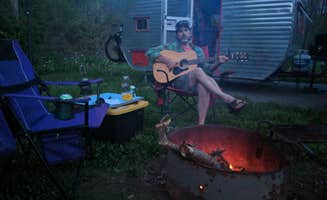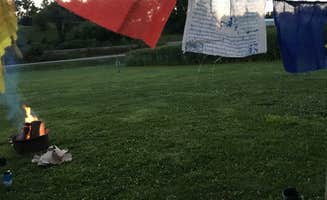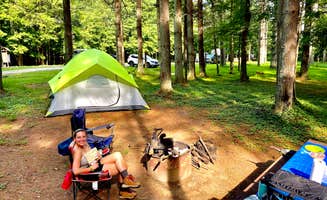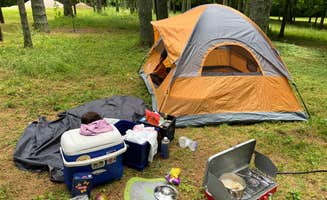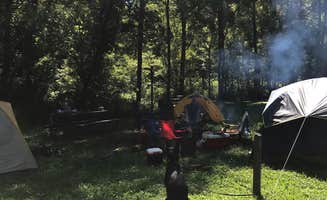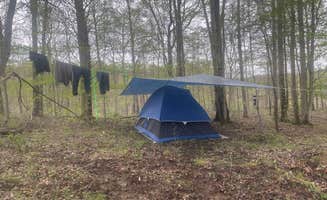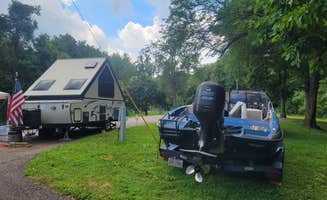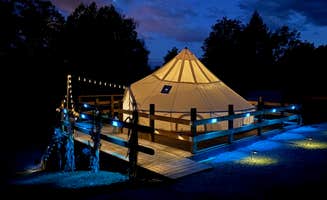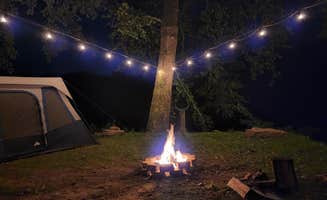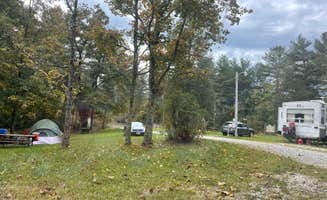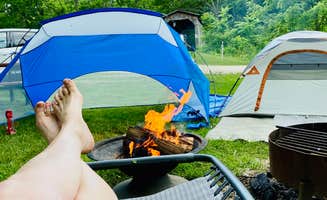Camping sites near Waverly, West Virginia offer diverse terrain with elevations ranging from 580 to 1,100 feet throughout the Ohio River Valley and adjacent Wayne National Forest. Late summer temperatures average 75-85°F with higher humidity near riverfront locations. Seasonal access varies significantly between Ohio and West Virginia camping areas, with spring flooding occasionally affecting riverside campsites.
What to do
Trail exploration: Kinderhook Horse Trail offers multiple hiking options beyond horseback riding. "Paw Paw trail was very smooth, dry and wide. The trail leads to the top of the hill," notes one visitor. The trails are maintained year-round but can become muddy after rainfall.
Rail-trail biking: North Bend State Park provides access to the extensive rail-trail system. "This humble campground is located on the 'Haunted' North Bend Rail to Trail. Great place to stay with plenty of room to enjoy yourself," shares a camper who visited for cycling. The rail-trail includes 35 bridges and 11 tunnels along a 72-mile route.
Water recreation: Harris RV Park offers direct Ohio River frontage. "Right on the Ohio River. Tight spots, but pretty level," notes a reviewer. Boat access is available for both motorized and non-motorized watercraft, making it convenient for anglers and paddlers.
What campers like
Accessibility to historic structures: Campers at Hune Bridge Campground appreciate the unique setting. "Adorable little campground, with a historic covered bridge and lovely creek in the backyard," one visitor notes. Though the bridge itself shows wear, the location provides a connection to regional history.
Affordability: Several campgrounds in the Wayne National Forest operate at no cost. "It is completely FREE, and you can stay for up to 14 days," explains a camper about Hune Bridge Campground. Similar free camping options exist throughout the national forest with 14-day stay limits.
Park facilities: Campers consistently mention the additional recreational opportunities at state parks. One visitor at North Bend State Park notes, "Plenty to do around the park - biking the rail trails, hiking, fishing, basketball, and a nice playground, to name a few!" Many campgrounds serve as hubs for broader park exploration.
What you should know
Site variations: Camping areas range from developed to extremely basic. At Cokeley Campground, "Most of the sites are not shaded, ours had partial shade." Dispersed sites may have minimal amenities but offer more seclusion.
Road access challenges: GPS directions often lead to problematic routes. "Do not follow GPS to get to North Bend SP (Cokeley or River Run). Call the park office directly. GPS took us up some nasty horse-shoe hills!" warns a recent visitor. Contact campgrounds directly for access information.
Water availability: Many primitive sites lack reliable water sources. At Kinderhook Horse Trail, one visitor notes there's "a small hand pump water spigot" but recommends bringing your own water. Wayne National Forest sites typically require campers to bring all necessary water.
Seasonal considerations: Most campgrounds in the area operate with reduced services during winter months. River Run Campground fills quickly during summer weekends when the swimming pool is operational, particularly when mountain bike races are scheduled.
Tips for camping with families
Kid-friendly amenities: River Run Campground offers dedicated facilities for children. "We had a wonderful time. The Park is great... We stayed during historic heat wave but kept cool in the river, the pool, and with the ice cream store nearby," explains a visitor with children. The swimming pool operates seasonally with lifeguards on duty.
Site selection strategy: Families report varying experiences based on specific site selection. "Nice spacing at our site in particular. I would also recommend sites 10, 11, 17, 19, 13, and 14," suggests a family who visited River Run Campground. Corner sites typically provide more space for children to play.
Wildlife viewing opportunities: Multiple campgrounds offer wildlife observation possibilities. "Winding down to River Run, deer in abundance were lining the roadway, so use care," notes one camper, highlighting both the opportunity and caution needed. Early morning and dusk provide best wildlife viewing conditions.
Tips from RVers
Hookup considerations: Mountwood Park Family Campground offers electrical connections with some limitations. "Some of the electric hookups had damage but being able to choose your spot upon arrival helped," reports an RVer. Inspecting electrical boxes before setup prevents potential issues.
Size restrictions: Many campgrounds have limited capacity for larger rigs. "FYI. Most of the sites seemed small so it might be best for smaller setups. Also I did not see any pull through sites," advises an RVer at Mountwood Park. Most sites accommodate units under 30 feet, with limited options for larger vehicles.
Arrival timing: Weekday arrivals provide better site selection opportunities. "The campground was pretty much empty. There are a few permanents there but we had it all to ourselves," shares a camper who visited Mountwood Park midweek. Holiday weekends often reach capacity by Friday afternoon.


